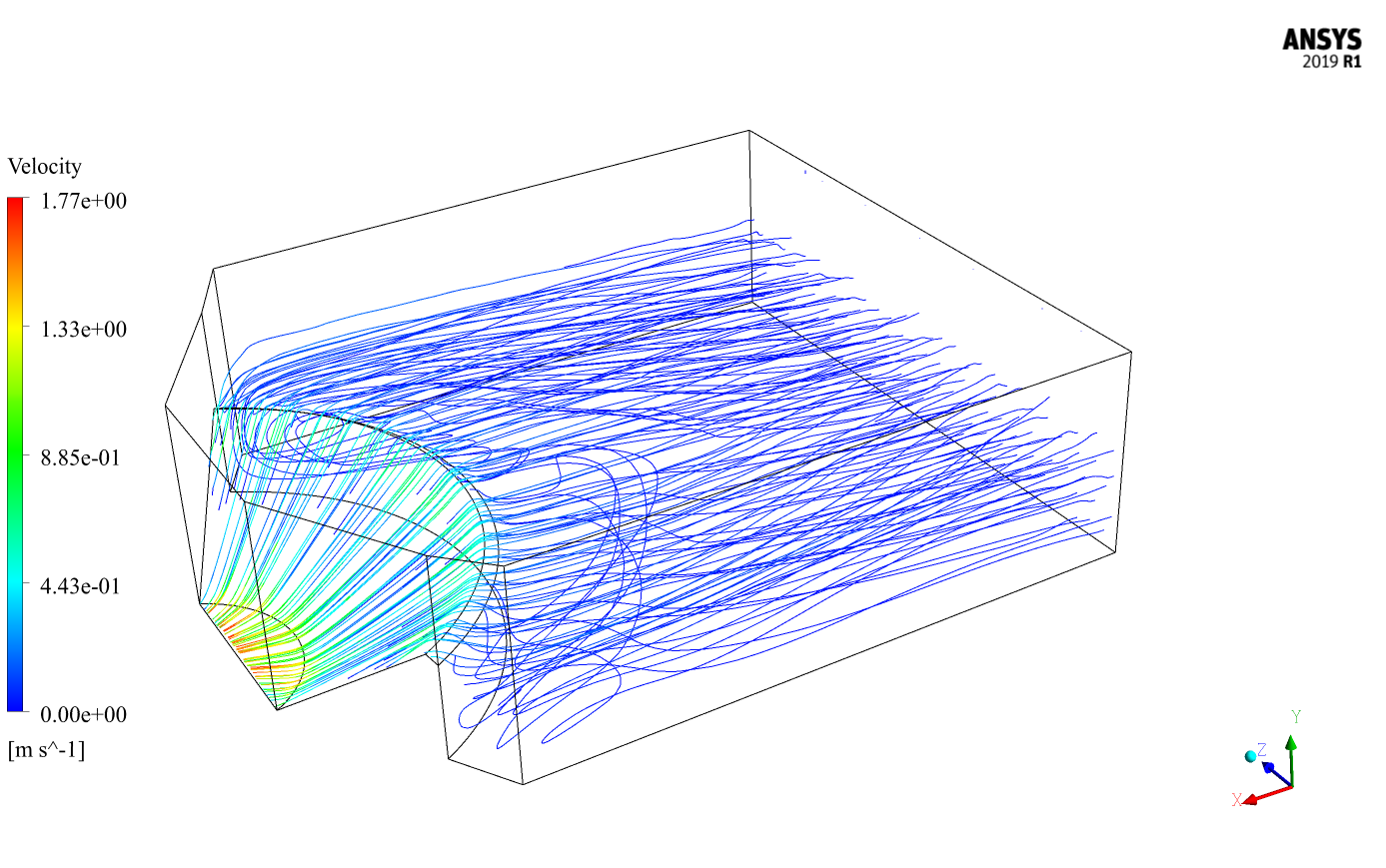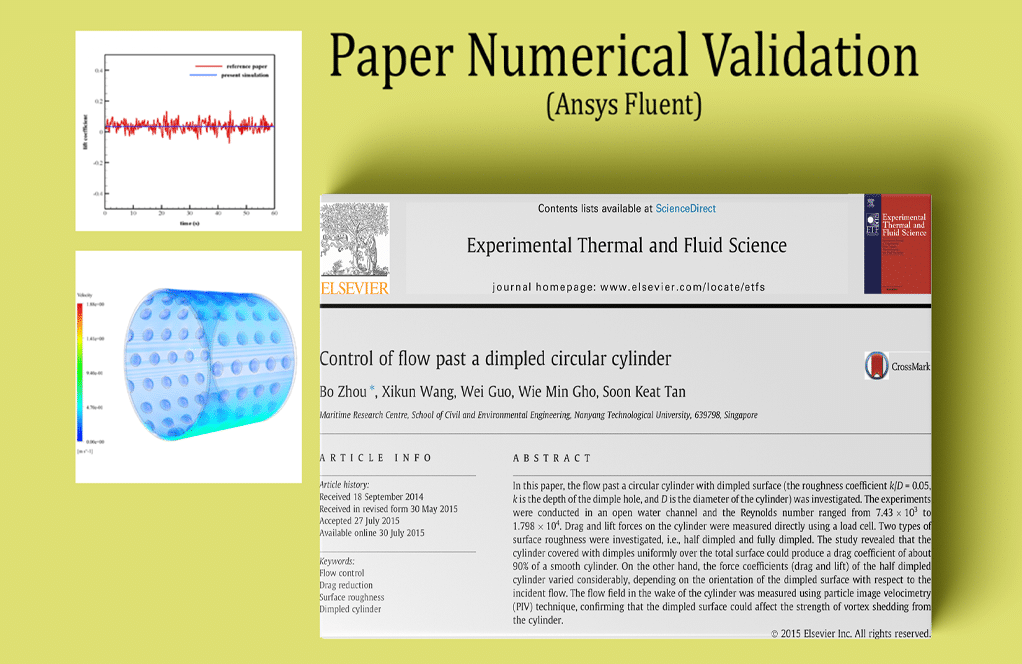Spillway (3-D & Transient), ANSYS Fluent CFD Simulation Tutorial
$100.00 $50.00 Student Discount
- The present problem simulates the flow of water through a spillway by ANSYS Fluent software.
- The 3-D geometry of the present model is designed using Design Modeler software.
- The meshing of the model has been done using ANSYS Meshing software and the element number is 698691.
- The Transient solver is applied.
- To define the two-phase flow in this simulation, a Multiphase VOF (volume of fluid) model is used, considering the Free Surface model.
Click on Add To Cart and obtain the Geometry file, Mesh file, and a Comprehensive ANSYS Fluent Training Video.
To Order Your Project or benefit from a CFD consultation, contact our experts via email (info@mr-cfd.com), online support tab, or WhatsApp at +44 7443 197273.
There are some Free Products to check our service quality.
If you want the training video in another language instead of English, ask it via info@mr-cfd.com after you buy the product.
Description
Description
In this project, we have modeled a 3-D spillway using ANSYS Fluent software. We perform this CFD project and investigate it by CFD analysis.
Spillways are structures used to pass through excess water and floods from the top to the bottom of the dam. In fact, spillways are structures with a certain height that discharge excess water when the height of the water exceeds its height.
There are different types of spillways, including ogee, step, side, lotus, tunnel, siphon, etc. spillways. The present problem simulates the flow of water through a spillway.
This simulation has been done as a multiphase simulation using air as a primary phase and water as a secondary phase. The height of the water level at the inlet is 0.155 m and the total height of the model is 0.306 m and considering that the height of the dam is 0.156 m.
The 3-D geometry of the present model is designed using Design Modeler software. The meshing of the model has been done using ANSYS Meshing software and the mesh type is unstructured. The element number is 698691.
Spillway Methodology
To define the two-phase flow in this simulation, a two-phase VOF (volume of fluid) model is used. Also, in this simulation, the gravity effect on the fluid is considered equal to -9.81 m/s2 along the y-axis.
Spillway Conclusion
The resulting contours show the performance of his spillway. It is clear that the water flow is well passed by the spillway. Most flow velocities are in the area where the geometry is smaller and the flow enters more densely.












Clovis Schmeler –
What is the benefit of using CFD for analyzing the spillway flow?
MR CFD Support –
CFD allows for detailed analysis of the flow characteristics over the spillway, which can provide valuable insights for design optimization and safety assessment.
Madeline Wolf IV –
Can the simulation results be used to optimize the design of the spillway?
MR CFD Support –
Yes, the simulation results can provide valuable insights into the flow behavior and pressure distribution in the spillway, which can be used to optimize its design for maximum efficiency and safety.
Kirk Stanton –
The tutorial for the spillway simulation was incredibly detailed. I was able to follow along and set up the multiphase VOF model with ease. Good job on providing a comprehensive guide that balances complexity and understanding.
MR CFD Support –
Thank you so much for your positive feedback! We’re glad to hear that the guide was both informative and easy to follow. If you need further assistance or have more questions in the future, don’t hesitate to reach out. Your success is very encouraging to us!
Zackary Cruickshank III –
The tutorial for simulating the spillway was extremely helpful. I could clearly understand how water flow is managed in a spillway structure and the significance of geometry in the flow distribution. Great work!
MR CFD Support –
Thank you so much for your kind words! We are thrilled to hear that you found our spillway simulation tutorial helpful and that it provided you with clear insights into the management of water flow. If you ever have any questions or need further assistance, feel free to reach out!
Easter Graham –
Just wanted to say great tutorial! The combination of 3-D modeling and the VOF method clarified a lot of concepts for me, especially in the context of spillway simulations. Well done!
MR CFD Support –
Thank you very much for your feedback! We’re thrilled to hear that our tutorial on ‘Spillway (3-D & Transient), ANSYS Fluent’ was able to enhance your understanding of spillway simulation and the VOF method. If you need further guidance or have more questions, feel free to reach out. Happy simulating!
Prof. Luciano Stokes –
How are the results of the simulation visualized?
MR CFD Support –
The results are visualized using contour plots of pressure and velocity, as well as pathlines of the flow.
Berenice Hamill –
great work. well done!
Danika Rohan –
The tutorial for the spillway simulation was very insightful. I could clearly understand how different elements affect the flow rate and patterns. The step-by-step explanation made it easy to follow and replicate. Great work creating an effective learning resource!
MR CFD Support –
Thank you for your kind words! We’re delighted to learn that our tutorial for the spillway simulation was helpful and easy to follow. We aim to provide our users with clear and comprehensive guidance so they can confidently apply CFD techniques to similar projects. Your feedback is greatly appreciated, and we look forward to assisting with any further learning endeavors you may have in the future!
Mr. Curtis Lindgren III –
Can I contribute to this simulation?
MR CFD Support –
We are open to contributions! Please share your ideas or suggestions.
And so on… You can continue this pattern of comments and answers, alternating between technical inquiries and suggestions for potential buyers.
Orrin McKenzie –
The tutorial was extremely helpful and provided a clear understanding of setting up and simulating a spillway in ANSYS Fluent. You explained multiphase flow dynamics perfectly. Great job!
MR CFD Support –
Thank you for your positive feedback! We’re delighted to hear that our tutorial on simulating a spillway in ANSYS Fluent was helpful to you. If there’s anything more we can assist you with regarding multiphase flow simulations or if you need more tutorials, don’t hesitate to reach out!
Amely Kohler Jr. –
I was impressed by the simulation of the spillway flow. Learning through such detailed visualizations offers a great way to understand the dynamics of fluid motions in complex scenarios.
MR CFD Support –
Thank you for your positive feedback! We’re glad the visualization in our spillway flow CFD simulation tutorial was helpful in understanding fluid dynamics. It’s wonderful to hear that our efforts to create detailed and accurate learning materials are appreciated.